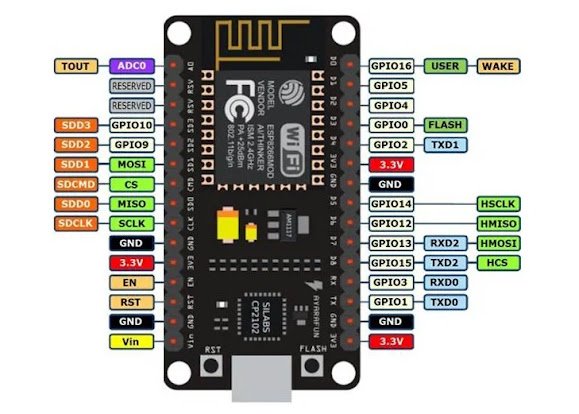NodeMCU
Introduction
The NodeMCU (Node MicroController Unit) is an open-source development board having Lua based firmware that run on the ESP8266 Wi-Fi SoC, developed by Espressif System, and hardware based on the ESP-12 module.
It is a low cost based which is mostly used in the field of IOT.
Description
NodeMCU is an open-source development board that is based on the ESP8266 microcontroller. It is designed for Internet of Things (IoT) applications and can be programmed using the Lua scripting language or the Arduino programming language.
- NodeMCU includes built-in Wi-Fi connectivity, which allows it to connect to the internet and to other devices.
- NodeMCU has a built-in microcontroller that can be programmed to perform various tasks such as reading sensor data, controlling actuators, and communicating with other devices.
- NodeMCU has a variety of input and output pins that can be used to connect to sensors, actuators, and other devices.
- NodeMCU is compatible with a wide range of development tools and frameworks, including the Arduino IDE and the Lua firmware.
- NodeMCU is relatively low cost and has a small form factor making it suitable for a wide range of IoT projects.
- NodeMCU can be used in a variety of applications such as home automation, sensor networks, and wireless control systems.
- NodeMCU is also compatible with a number of other IoT platforms such as Blynk, Adafruit IO, and Thingspeak, which allows for easy data collection and visualization.
- NodeMCU can be powered by a USB cable or a lithium-ion battery, making it portable and easy to use in a variety of environments.
- NodeMCU is open-source which means it can be modified, customized and used freely.
It's worth noting that NodeMCU is constantly evolving and changing, so the information I've provided is accurate at the time of my knowledge cut-off and there may be newer developments or advancements in the field
Pin DiagramThe diagram below shows the pin diagram of Nodemcu:
The Nodemcu consists of 30 pins out of which there are 17 GPIO pins.


Comments
Post a Comment